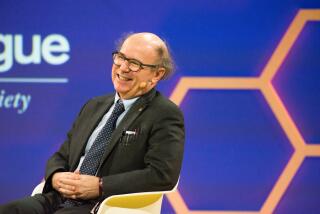Man Fascinated by Randomness of Life
- Share via
Can a clever fellow outwit fate? If he knows that the chances of boarding a plane with a bomb on board are 1 in 100,000, but only 1 in 100,000x100,000 of boarding a plane with two bombs on board, shouldn’t he carry his own bomb and thus reduce the odds of a midair explosion to almost zero?
Not at all, according to Mark Kac, who died a year ago, in “Enigmas of Chance” (Harper & Row). In this absorbing memoir, the mathematician who did a great deal to establish probability theory as a branch of formal mathematics explains why it isn’t worth smuggling on a second bomb. Each individual boarding with his bomb is a separate event, independent from the other. No matter what a second person has in her luggage, the probability of there being a second bomb on the plane remains the same. It is the same logic that gamblers know. Each roll of the dice is a separate event. The player always starts from scratch. Even if he rolls seven 10 times in a row, the probability that he may roll seven yet again is the same as it was before his first throw. With these anecdotes, Kac illustrates how probability theory arises in familiar events, even the admittedly apocryphal situation of the airplane bomber.
Kac’s memoir might well have been called “The Joys of Math.” A room-filling enthusiastic personality, Kac enjoyed the “quickening of feeling that comes with an idea,” and rejoiced in the application of purely abstract constructs to real life.
Living a Double Life
More than any other mathematician I have read, Kac describes what it is like to live a double life: half of the time in the material world, enjoying family and friends and linguistic bloopers; the rest of the time in a world of the mind. Kac tells us that for his beloved teacher, Hugo Steinhaus, “Mathematics was a mirror of reality and life, in much the same way as poetry is such a mirror . . . he liked to play with numbers, sets and curves the way a poet plays with words, phrases and sounds.”
Kac admired Steinhaus for his ability to translate mathematical abstractions into practical applications. Before the days of genetic screening, Steinhaus proposed a logical method for estimating the probability that a woman would lie in a paternity suit. During World War II, when Steinhaus hid in Nazi-occupied Poland, he was able accurately to estimate German losses by reading the obituaries and noting after late 1942 and 1943 that things were very grave because the announcements had begun to read “the second of the sons,” to fall in action.
Kac was fascinated by the randomness of life. Probability theory can predict proportions and the likelihood of particular events, but not the actual fate of individual atoms, molecules or people. The arbitrary nature of numbers haunted his life, starting with his date of birth, which was recorded first in the Julian calendar as Aug. 16--the area in which he lived was then controlled by the czars--and then changed to Aug. 3 in accordance with the Gregorian calendar after World War I when his hometown of Kremenetz became part of a newly re-created Poland.
Changing nationalities from Russian to Polish, Kac knew a world in which ethnic groups battled for superiority while the Jewish middle class, of which his family was a part, struggled to find some acceptance. These rivalries led to bad luck that turned out to be good luck and allowed him to survive the war. He failed to win a traveling scholarship in 1937 and so postponed his visit to the United States until 1938, stranding him on this side of the ocean in 1939, so that he lived while almost all of his family, friends and teachers were swallowed up by the barbarities visited upon them by the German invasion.
Realities of Anti-Semitism
Kac describes the mental pleasures he experienced at the university in Poland in counterpoint to the crude realities of anti-Semitism before the war. He also relates the ways in which some of his mathematical colleagues coped with the war and captivity by performing mathematical gymnastics under obscene conditions.
Kac himself does not seem to have been above stopping in mid-sentence to work out a formula, just for the pleasure of the process, and this lends a feeling of spontaneity to these reminiscences. An exuberant, joyful scholar, his narrative reads like a dinner-table conversation during which he interrupts himself to tell yet another story that is connected, tangentially, to the one he has already begun.
Kac loved the practical applications to which physicists such as Richard Feynman put his probability and statistical theories. When his two worlds intersected, the everyday life and the life of the mind, Kac was delighted. He seemed to have enjoyed nothing so much as demonstrating that randomness does not mean chaos, and that there is order in general even when the particular cannot be predicted.
More to Read
Sign up for our Book Club newsletter
Get the latest news, events and more from the Los Angeles Times Book Club, and help us get L.A. reading and talking.
You may occasionally receive promotional content from the Los Angeles Times.










